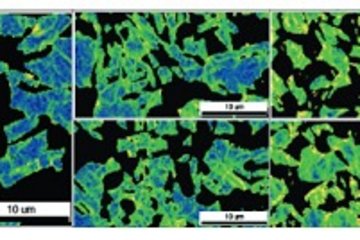All genres
2241.
Poster
Thermomechanical Treatment of a Fe3Al Alloy. Junior DGM-Tag 2005, Hanau, Germany (2005)
2242.
Poster
Structure and texture analysis of chitin-bio-nanocomposites using synchrotron radiation. MRS Spring Meeting, San Francisco, CA, USA (2005)
2243.
Poster
Mesostructure, microstructure and anisotropy of the lobster cuticle. MRS Spring Meeting, San Francisco, CA, USA (2005)
2244.
Poster
Influence of sample preparation and anisotropy on lobster claw studied by LOM, SEM and TEM. Focus on Microscopy, Jena, Germany (2005)
2245.
Poster
3D experimental investigation and crystal plasticity FEM simulation of the texture and microstructure below a nanoindent in a Cu-single crystal. 6th European Symposium on nano-mechanical Testing (Nanomech 6), Hückelhoven, Germany (2005)
2246.
Poster
Deformation Behavior of a Fe3Al Alloy During Thermomechanical Treatment. MRS Fall Meeting, Boston, MA, USA (2004)
2247.
Poster
Orientation dependent growth behaviour of subgrain structures in IF steel. 2nd International Joint Conference on Recrystallization and Grain Growth, Annecy, France (2004)
2248.
Poster
Nucleation Mechanisms of Recrystallization in Warm Rolled Fe3Al Base Alloys. Discussion Meeting on the Development of Innovative Iron Aluminium Alloys, MPIE, Düsseldorf, Germany (2004)
2249.
Poster
Development of a Grain Fragmentation Criterion and its Validation using Crystal Plasticity FEM Simulations. Meeting, Düsseldorf, Germany (2004)
2250.
Teaching
Sustainable Materials Science and Green Metallurgy. Lecture: SS 2024, RWTH Aachen University, 2024-03 - 2024-07
2251.
Teaching
Sustainable Materials Science and Green Metallurgy. Lecture: SS 2023, RWTH Aachen University, 2023-03 - 2023-07
2252.
Teaching
Sustainable Materials Science and Green Metallurgy. Lecture: SS 2022, RWTH Aachen University, 2022-03 - 2022-07
2253.
Teaching
Sustainable Materials Science and Green Metallurgy (Sustainable Materials and Metallurgical Science & Engineering). Lecture: SS 2021, RWTH Aachen University, 2021-04 - 2021-07
2254.
Teaching
Sustainable Materials Science and Green Metallurgy. Lecture: SS 2020, RWTH Aachen University, 2020-03 - 2020-07
2255.
Teaching
Micromechanics of Materials. Lecture: SS 2020, RWTH Aachen University, 2020-04 - 2020-07
2256.
Teaching
Micromechanics of Materials. Lecture: SS 2018, RWTH Aachen University, 2018-04 - 2018-07
2257.
Teaching
Micromechanics of Materials. Lecture: Summer semester 2014, RWTH Aachen, Aachen, Germany, March 23, 2015 - July 17, 2015
2258.
Teaching
Dislocations and Interfaces - Materials Mechanics. Lecture: SURMAT IMPRS Teaching / Max Planck Research School, Düsseldorf, Germany, April 28, 2015
2259.
Teaching
Advanced Constitutive Models for Crystal Plasticity Simulations - Fundamentals, Implementation, Application. Lecture: Winter School 2014, Research Training Group 1483, KIT, Karlsruhe, Germany, March 18, 2014
2260.
Teaching
Micromechanics of Materials. Lecture: Summer semester 2014, RWTH Aachen, Aachen, Germany, April 07, 2014 - July 18, 2013











